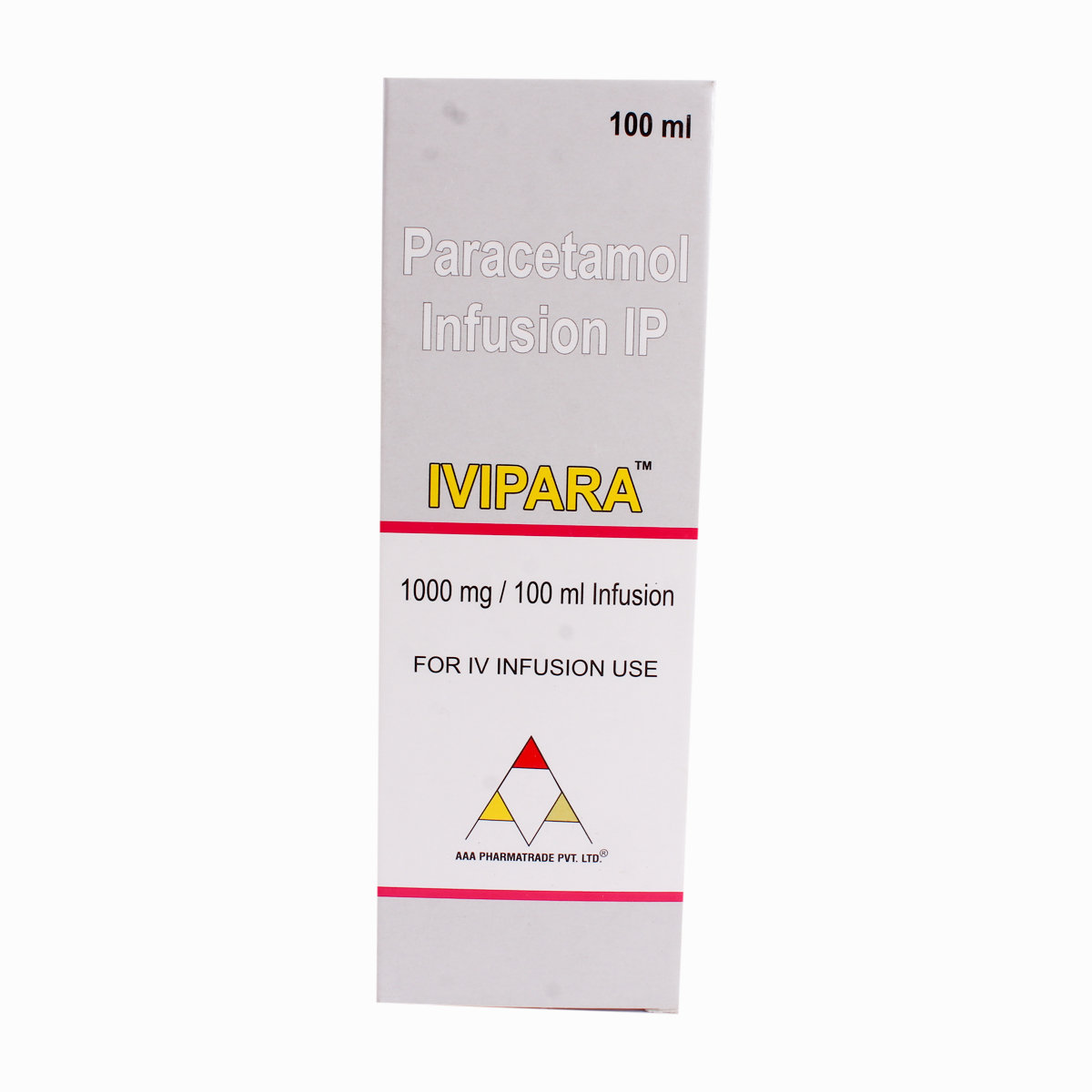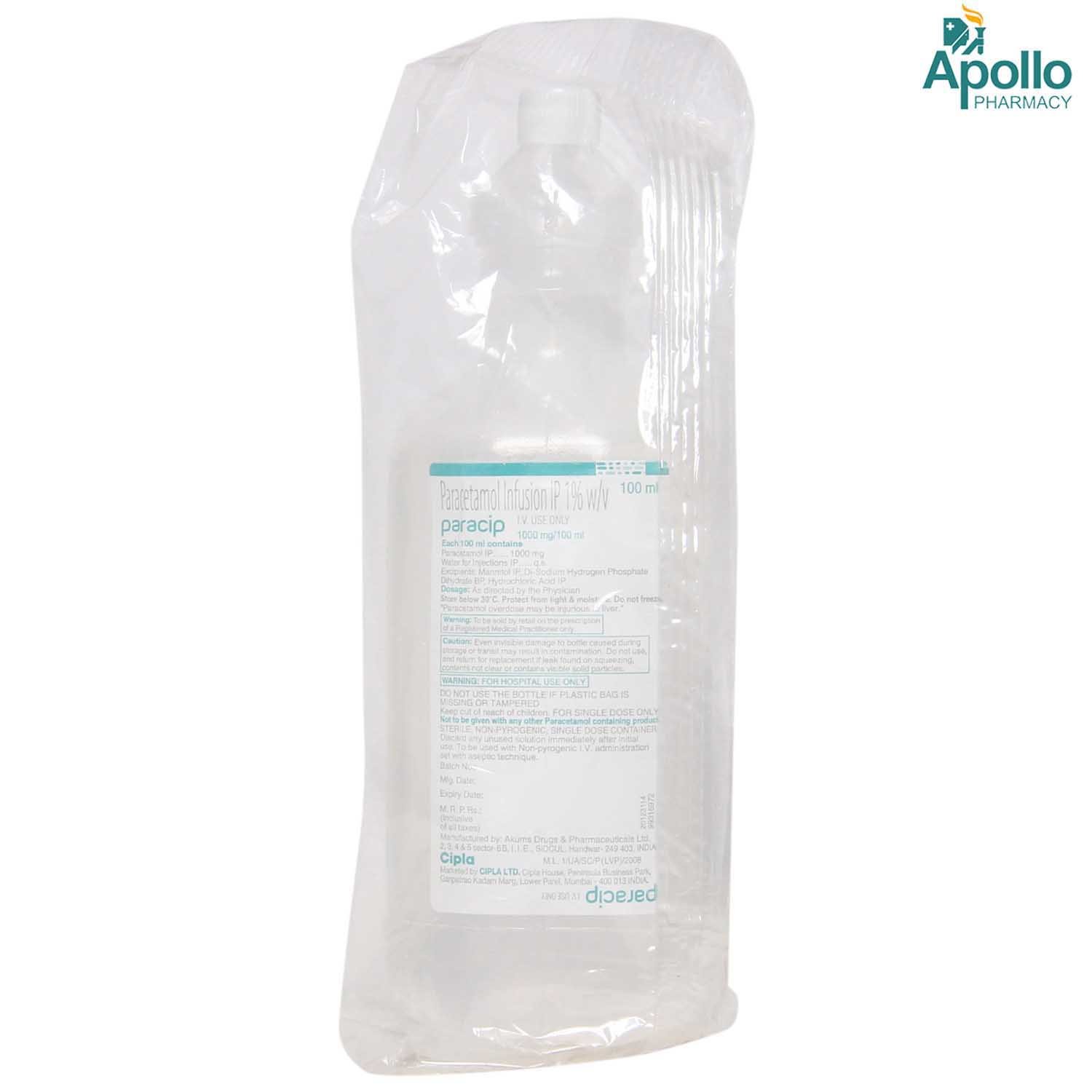Paracetamol 1 gm Injection 1's
Paracetamol 1 gm Injection belongs to the group of analgesics (pain killers)


MRP ₹288.5
(Inclusive of all Taxes)
₹43.3 Cashback (15%)
Provide Delivery Location
Online payment accepted
 Prescription drug
Prescription drugWhats That
Composition :
Manufacturer/Marketer :
Consume Type :
Expires on or after :
Return Policy :
About Paracetamol 1 gm Injection
Paracetamol 1 gm Injection belongs to the group of medicines called analgesic and antipyretic agents, primarily used to relieve mild to moderate pain and to treat fever. Pain is a symptom triggered by the nervous system, which causes uncomfortable sensations in the body. Fever occurs when the body's temperature goes above the average body temperature (98.6°F or 37°C).
Paracetamol 1 gm Injection contains 'Paracetamol,' which prevents the formation of chemical messengers called prostaglandins, which cause pain and swelling at the injury sites. This process reduces the mild to moderate pain and inflammation at the injured or damaged site. Paracetamol 1 gm Injection also affects an area of the brain that regulates body temperature known as the hypothalamic heat-regulating centre. Thus, it reduces fever.
Your doctor will decide the dose and duration of Paracetamol 1 gm Injection based on the severity of your medical condition. Common side effects of Paracetamol 1 gm Injection include constipation, nausea, and vomiting. These side effects are not familiar to everyone and vary individually. If you notice any side effects that are not manageable, please consult your doctor.
Please tell your doctor if you are allergic to any of the components of Paracetamol 1 gm Injection. Let your doctor know if you use any other pain killers before starting this medicine. Inform your doctor if you have liver or kidney diseases, malnutrition, dehydration, and a history of alcoholism before starting Paracetamol 1 gm Injection. It is essential to let your doctor know if you are pregnant, planning to conceive or are a breastfeeding mother. It is not recommended to consume alcohol while using Paracetamol 1 gm Injection.
Uses of Paracetamol 1 gm Injection
Directions for Use
Key Benefits
Paracetamol 1 gm Injection contains 'Paracetamol,' which is an analgesic (relieves pain) and an antipyretic (reduces fever). It prevents the formation of chemical messengers called prostaglandins, which cause pain and swelling at the injury sites. This process reduces the mild to moderate pain and inflammation at the injured or damaged site. Paracetamol 1 gm Injection also affects an area of the brain that regulates body temperature known as the hypothalamic heat-regulating centre. Thus, it reduces fever.
Storage
Drug Warnings
Let your doctor know if you use any prescription and non-prescription medications, including other vitamins, before starting Paracetamol 1 gm Injection. Notify your doctor if you have any intolerance or allergy to any of the components in Paracetamol 1 gm Injection. Inform your doctor if you have liver or kidney diseases, malnutrition, dehydration, and a history of alcoholism before starting Paracetamol 1 gm Injection. Please consult your doctor know if you are pregnant, planning to conceive or are a breastfeeding mother. Do not consume alcohol while being treated with Paracetamol 1 gm Injection.
Diet & Lifestyle Advise
- Performing yoga may help in improving overall flexibility and pain management.
- Maintain a healthy weight by performing regular low-strain exercises and eating healthy food.
- Get adequate sleep as resting the muscles can help in reducing inflammation and swelling.
- Follow heat or cold therapy; apply a cold or hot compress on the joints for 15-20minutes regularly.
- Acupuncture, massage, and physical therapy may also be helpful.
- Eat food rich in antioxidants such as berries, spinach, kidney beans, dark chocolate, etc.
- Foods containing flavonoids help in reducing inflammation. These include soy, berries, broccoli, grapes, and green tea.
- Avoid smoking and alcohol consumption.
Side Effects of Paracetamol 1 gm Injection
- Constipation
- Nausea
- Vomiting
Habit Forming
Therapeutic Class
All Substitutes & Brand Comparisons
RX
Hospimol UB IV Infusion 100 ml
Alkem Laboratories Ltd
₹276
(₹2.48/ 1ml)
99% CHEAPERRX
Out of StockGpara-IV Infusion 100 ml
Gi Pharma
₹296
(₹2.96/ 1ml)
98% CHEAPERRX
Out of StockBRAVEMOL IV 100ML
Fountil Life Sciences Pvt Ltd
₹350
(₹3.15/ 1ml)
98% CHEAPER
Product Substitutes
Author Details
We provide you with authentic, trustworthy and relevant information
FAQs
Paracetamol 1 gm Injection works by blocking the effect of chemical messengers (prostaglandins), thereby reducing fever, pain, stiffness, swelling, and inflammation.
It is not advised to take Paracetamol 1 gm Injection on your own. You should use Paracetamol 1 gm Injection only if a healthcare professional prescribes it.
Paracetamol 1 gm Injection is to be cautiously used in case of any allergic reactions to other pain killers. Let your doctor know your medical history before starting Paracetamol 1 gm Injection.
Though Paracetamol 1 gm Injection is usually safe to use, it may very rarely cause serious skin reactions like generalized exanthematous pustulosis (AGEP), Stevens-Johnson Syndrome (SJS), and toxic epidermal necrolysis (TEN). Please discontinue the usage of Paracetamol 1 gm Injection if you notice any skin rash and consult your doctor immediately.
Drug-Drug Interactions Checker List
- PROBENECID
- WARFARIN
- ACENOCOUMAROL
- SALICYLAMIDE
Disease/Condition Glossary
Pain: It is not a disease but a symptom triggered by the nervous system, causing uncomfortable sensations in the body. Pain may be dull or sharp; it might be constant or may come and go. The tolerance level of pain might vary from person to person. Pain can be generalized (overall body aches) or localized (affecting a specific area of the body).
Fever: When the body's temperature goes above the average temperature of 98.6°F (37°C), it is called fever or pyrexia. It is considered as a response of the body's immune system to external factors.

Have a query?
Buy best C.n.s Drugs products by
Intas Pharmaceuticals Ltd
Sun Pharmaceutical Industries Ltd
Torrent Pharmaceuticals Ltd
Alkem Laboratories Ltd
Abbott India Ltd
Cipla Ltd
Alteus Biogenics Pvt Ltd
Micro Labs Ltd
Lupin Ltd
Ipca Laboratories Ltd
D D Pharmaceuticals Pvt Ltd
Icon Life Sciences
Mankind Pharma Pvt Ltd
Tripada Healthcare Pvt Ltd
Arinna Lifesciences Ltd
Linux Laboratories Pvt Ltd
East West Pharma India Pvt Ltd
La Renon Healthcare Pvt Ltd
Talent India Pvt Ltd
Tas Med India Pvt Ltd
Zydus Healthcare Ltd
Cnx Health Care Pvt Ltd
Eris Life Sciences Ltd
Leeford Healthcare Ltd
Emcure Pharmaceuticals Ltd
Macleods Pharmaceuticals Ltd
Sigmund Promedica
Aristo Pharmaceuticals Pvt Ltd
Dr Reddy's Laboratories Ltd
Troikaa Pharmaceuticals Ltd
Consern Pharma Ltd
Zydus Cadila
Shine Pharmaceuticals Ltd
Wockhardt Ltd
Ardent Life Sciences Pvt Ltd
Crescent Formulations Pvt Ltd
Theo Pharma Pvt Ltd
Reliance Formulation Pvt Ltd
Ikon Pharmaceuticals Pvt Ltd
Propel Healthcare
Neon Laboratories Ltd
Jagsam Pharma
Msn Laboratories Pvt Ltd
Morepen Laboratories Ltd
Pulse Pharmaceuticals
Sanofi India Ltd
Med Manor Organics Pvt Ltd
Hetero Healthcare Pvt Ltd
Novartis India Ltd
Crescent Therapeutics Ltd
Elder Pharmaceuticals Ltd
Solvate Laboratories Pvt Ltd
Akumentis Healthcare Ltd
Mova Pharmaceutical Pvt Ltd
Psyco Remedies Ltd
Tripada Lifecare Pvt Ltd
Ajanta Pharma Ltd
Cyrus Remedies Pvt Ltd
Medishri Healthcare Pvt Ltd
Cadila Healthcare Ltd
Glenmark Pharmaceuticals Ltd
Matteo Health Care Pvt Ltd
Hbc Life Sciences Pvt Ltd
Lyf Healthcare
Matias Healthcare Pvt Ltd
Mesmer Pharmaceuticals
Alembic Pharmaceuticals Ltd
Capital Pharma
Crescent Pharmaceuticals
Medopharm Pvt Ltd
Alniche Life Sciences Pvt Ltd
Kivi Labs Ltd
Talin Remedies Pvt Ltd
USV Pvt Ltd
Quince Lifesciences Pvt Ltd
Solis Pharmaceuticals
Infivis Life Care
Zuventus Healthcare Ltd
Cadila Pharmaceuticals Ltd
Pfizer Ltd
Wallace Pharmaceuticals Pvt Ltd
A N Pharmacia Laboratories Pvt Ltd
Blue Cross Laboratories Pvt Ltd
Jenburkt Pharmaceuticals Ltd
Lia Life Sciences Pvt Ltd
Mano Pharma
Medley Pharmaceuticals Ltd
Primus Remedies Pvt Ltd
FDC Ltd
Maneesh Pharmaceuticals Ltd
Apex Laboratories Pvt Ltd
Gagnant Healthcare Pvt Ltd
Ozone Pharmaceuticals Ltd
RPG Life Sciences Ltd
Strides Shasun Ltd
Unichem International
GlaxoSmithKline Pharmaceuticals Ltd
Kuresys Labs Pvt Ltd
LA Pharma
Trion Pharma India Llp
Alcohol
Safe if prescribed
You are recommended to avoid alcohol consumption while taking Paracetamol 1 gm Injection. Alcohol intake, along with Paracetamol 1 gm Injection may cause increased liver damage.
Pregnancy
Consult your doctor
Please consult your doctor before taking Paracetamol 1 gm Injection if you are a pregnant.
Breast Feeding
Consult your doctor
Paracetamol 1 gm Injection should be used during breastfeeding only when suggested by a doctor.
Driving
Safe if prescribed
Paracetamol 1 gm Injection does not usually affect your ability to drive.
Liver
Consult your doctor
Please consult your doctor since Paracetamol 1 gm Injection should be used with caution in patients with liver impairment/liver disease.
Kidney
Consult your doctor
Please consult your doctor since Paracetamol 1 gm Injection should be used with caution in patients with kidney impairment/kidney disease.
Children
Safe if prescribed
Paracetamol 1 gm Injection should be given to children only when prescribed by a doctor







_0.jpg?tr=q-85)
